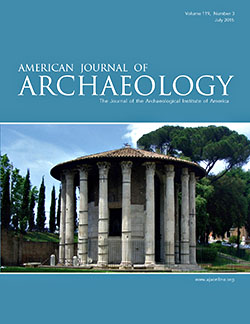AJA Open Access
BY-NCJuly 2015 (119.3)
Book Review
Network Analysis in Archaeology: New Approaches to Regional Interaction
Edited by Carl Knappett
Reviewed by Justin Jennings
Over the past few decades, archaeologists have increasingly problematized the cultural “spheres,” “horizons,” and, yes, “networks” that linked different groups together in the past. We now readily recognize that processes such as romanization were far more complicated and dynamic than initially described, and we acknowledge our ignorance of the intricacies of the bridle’s spread across the Asian steppes or the introduction of maize into the Andes. The challenges of detailing regional interactions and how they change over time are thus daunting, and one can perhaps be forgiven for retreating back to the narrow empiricism of site reports. In this ambitious volume, Knappett and his colleagues do the opposite. They dive into the mess, suggesting that network analysis can be an effective tool for understanding regional interactions in all of their complexities.
As Knappett discusses in the introductory chapter, networks can seem like an unlikely savior. The term itself is a well-trodden, if vaguely applied, one in archaeology, and the essence of network analysis—creating a set of nodes with links among them—at first appears to be far too blunt a tool for the nuanced relationships that we hope to untangle. Yet Knappett convincingly argues that network approaches are ideally suited to studying complex systems, and that the very act of defining nodes (is it an individual? site? polity?) and links (marriage ties? tribute? pilgrimage?) forces us to wrestle explicitly with assumptions that are often left unexplored.
The volume’s 13 case studies span the globe and take us from the Epipaleolithic to the present day. Each contribution differs in its approach to the archaeological record, showing the wide variety of data sets that are amenable to network analysis. Mizoguchi, for example, chooses provinces as the nodes in his study of the prestige-goods system of Yayoi-period Japan, while Collar uses inscriptions to trace the Jewish Diaspora throughout the Mediterranean world. Terrell employs social network analysis (SNA) to probe the relationship between linguistic and artifact variation in New Guinea; Rivers, Knappett, and Evans develop a new model for Minoan-period interaction called “ariadne,” which they argue more deftly deals with optimization, exchange, and dynamism. Coward uses a cost-surface model to evaluate shifting relationships in the Neolithic Near East.
With such disparate data sets being considered, there is a danger of scholars talking past one another as they employ network approaches in varying ways. All of these contributors, moreover, as Isaksen notes in his chapter, visualize their networks differently. Most, such as Blake for pre-Roman Italy and Mills and her colleagues for the Pueblo southwest, use the simple, more familiar network graphs popularized in SNA. Others pack more into their figures, with Mol and Mans’ psychedelic rendering of the relationships within a contemporary Caribbean village taking a glass of wine to comprehend fully. The metrics used to describe these networks also differ from one contributor to the next—one quickly recognizes how slippery “closeness,” “centrality,” and “equivalence” are when trying to quantify these terms. Differences can also be seen in the ways that authors inject geography into their models and how they attempt to capture change over time. The breadth of approaches in the volume is exhilarating, but this variation is also a reflection of the considerable challenges of applying systems analysis to archaeological data sets.
Sindbӕk’s chapter on the Vikings is particularly eloquent in describing what he calls the “black box problem” of archaeology (75). While network analysis was largely developed to understand relationships among a known set of entities, archaeological data is fragmented and incomplete. We rarely know all of the nodes—however defined—in a network, and we usually have only an inkling of the multifaceted links that connected these nodes. Even in the best-case scenarios, such as when Scholnick, Munson, and Marci can read about elite relationships from Maya hieroglyphs, we have to first reconstruct an archaeological network before it can be analyzed. The best practices of scaffolding from known to unknowns (putting aside the dilemma of Rumsfeld’s unknown unknowns) remain unclear. This, though, is a problem endemic to archaeology in general, and many of the contributors should be applauded for their clear-eyed efforts at overcoming data deficiencies.
It can sometimes be distressingly easy to poke holes in the arguments of these case studies. Treating an island as a node, for example, seems needlessly reductive, and tracking imports—or inscriptions—is a woefully incomplete measure of relationships among nodes. Yet, and this point should be emphasized, this is the beauty of network analysis. The approach forces us to be explicit about our data, how we classify them, and how we analyze them. Network analysis thus tends to dig up buried assumptions, expose leaps of judgement, and even muzzle attempts at theoretical derring-do. Network analysis takes off the caked-on theater makeup of our discipline, providing critical new insights while also often exposing the poverty of our data sets, especially at a regional level. Wider application of the approach will keep us honest and make us better scholars.
In the closing chapter, van der Leeuw argues that archaeology’s continued relevance requires a shift in focus from “being” to “becoming” (337). An emphasis on dynamism and innovation requires a better handle on the shifting relationships among people, objects, and other entities over the long term. Knappett has assembled a timely, provocative book that demonstrates the considerable power of network approaches for studying interaction in archaeological contexts. By thinking in terms of nodes and links, the authors frequently expose how little we truly know about the ancient world. Yet at the same time, the scholarship in this volume shows network analysis’ potential for becoming a critical tool in our efforts to reconstruct the rich tapestries of relationships that have long bound us together.
Justin Jennings
Department of World Cultures
Royal Ontario Museum
